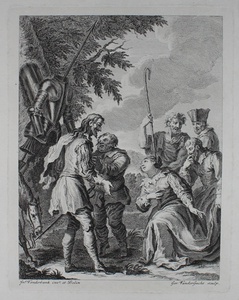| Method | Copper engraving and etching |
| Artist | Gerard van der Gucht after John Vanderbank |
| Published | [Published in London by J. and R. Tonson and Robert Dodsley, c. 1742] |
| Dimensions | 250 x 188 mm, 270 x 208 mm, 380 x 272 mm |
| Notes |
Don Quixote and Sancho meet Dorothea in the Sierra Morena mountains. When they first encounter Dorothea, she is disguised as a young man, and uses a false name. Her true identity is discovered however when she lets down her hair one day while bathing, and being an obviously beautiful woman, she is persuaded to tell her story to Don Quixote and the other men. Dorothea has fled to the wood after she had been deceived by Don Fernando, the Duke's son. He had fallen in love with her and eventually paid of one of her housekeepers to sneak him into her bedroom. He then convinced Dorothea to sleep with him, promising marriage. When Don Fernando disappeared afterwards with no real intention of marring Dorothea, she runs from home and searches for him. She then hears her named called out on the street, and people are looking for her. Frightened she will be stopped before she can find Don Fernando, she runs to hide in the woods. Unfortunately, she is then pursued by the shepherds of the area, which is why she had disguised herself as a man. After hearing Dorothea's story, one of the men in Don Quixote's company, Cardenio is able to help Dorothea find Don Fernando and convince him to marry her. She then decides to help Cardenio and the other men to trick Don Quixote in hopes of getting him back home. Dorothea dresses up as a princess and begs Don Quixote to defeat an evil giant who has exiled her from her kingdom Micomicon. Volume I, page 184, illustration to chapter titled: "Which treats of the beautiful Dorothea's discretion, with other very ingenious and entertaining particulars" from Vanderbank's "The Life and Exploits of the Ingenious Gentleman Don Quixote de la Mancha". Gerard van der Gucht (c.1696-1776) was an English engraver and art dealer. Born in London, he was the son of the Flemish engraver Michael van der Gucht. He, and his younger brother Jan van der Gucht (c.1699-c.1730), were both taught engraving by their father. Van der Gucht was also taught drawing by Louis Chéron, and studied at Godfrey Kneller's Great Queen Street Academy. By adopting the French method of combining etching and engraving, he became one of the leading engravers in London at that time. Van der Gucht worked for various printsellers and booksellers until his father's death in 1725, when he took over his business at the Golden Head in Queen Street, Bloomsbury. In the same year he married Mary Liney; their children included the painter and art dealer Benjamin van der Gucht (1753-1794). In 1735, he took a leading role in the demand for an extension to the Engraving Copyright Act of 1734, to include all prints. A member of the Society for the Encouragement of Arts, Manufactures, and Commerce, van der Gucht worked for the rest of his life as an art dealer, and engraver and publisher of an assortment of subjects. John Vanderbank (1694 - 1739) was a British painter and draughtsman. The son of John Vanderbank a Soho tapestry-weaver, Vanderbank studied under Sir Godfrey Kneller at James Thornhill's art academy in Great Queen Street from 1711 until 1720, when he joined with Louis Chéron to found his own academy in St Martin's Lane. Vanderbank enjoyed a high reputation for a short while during the reign of King George I, but died relatively young due to an intemperate and extravagant lifestyle. Condition: Good impression with wide margins. Slight overall time toning. Overall creasing to edges of sheet. |
| Framing | unmounted |
| Price | £30.00 |
| Stock ID | 47679 |

